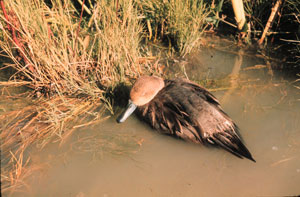Avian Botulism
Avian botulism is a paralytic disease caused by ingestion of a toxin produced by the bacteria,
Clostridium botulinum. This bacteria is widespread in soil and requires warm temperatures,
a protein source and an anaerobic (no oxygen) environment in order to become active and produce toxin.
Decomposing vegetation and invertebrates combined with warm temperatures can provide ideal
conditions for the botulism bacteria to activate and produce toxin. There are several types
of toxin produced by strains of this bacteria; birds are most commonly affected by
type C and to a lesser extent type E.
Birds either ingest the toxin directly or may eat invertebrates (e.g. chironomids, fly larvae)
containing the toxin. Invertebrates are not affected by the toxin and store it in their
body. A cycle develops in a botulism outbreak when fly larvae (maggots), feed on animal
carcasses and ingest toxin. Ducks that consume toxin-laden maggots can develop botulism
after eating as few as 3 or 4 maggots.
Host
- Type C toxin: waterfowl, shorebirds, colonial waterbirds, and others
- Type E toxin: gulls, loons, and others
Clinical Signs/Field Signs
Healthy birds, affected birds, and dead birds in various stages of decay are commonly
found in the same area. The toxin affects the nervous system by preventing impulse
transmission to muscles. Birds are unable to use their wings and legs normally or control the
third eyelid, neck muscles, and other muscles. Birds with paralyzed neck muscles cannot hold their heads up and often
drown. Death can also result from water deprivation, electrolyte imbalance, respiratory failure, or predation.
Lesions
There are no specific lesions associated with this disease. Diagnosis of
botulism is based on demonstration of the toxin in serum from sick birds,
or tissue samples from dead birds such as clotted heart blood, stomach contents, or liver.
Wildlife Management Significance
Outbreaks occur from coast to coast in the United States and Canada,
generally from July through September. Thousands of birds may die during a single outbreak.
Prompt removal and proper disposal of carcasses by burial or burning
(in accordance with applicable ordinances) is highly effective in
removing toxin and maggot sources from the environment. If possible
avoid altering water depth by flooding or drawing down water levels during
hot weather. This may increase invertebrate and fish die-offs, a protein source for the bacteria.
Providing mildly affected birds with fresh water, shade and
protection from predators may help them recover from the intoxication.
Botulism antitoxin is available but requires special handling and must be
given early in the intoxication. Birds that survive a botulism outbreak are NOT immune to botulism toxin.
For additional information on this or any other wildlife health issue, contact
the National Wildlife Health Center at (608) 270-2400.
|

Public Health Significance
Botulism in humans is usually the result of eating improperly home-canned foods,
which contain types A or B toxin. Type E toxin has been associated with improperly
smoked fish. People, dogs, and cats are generally thought to be resistant to
type C toxin, but a few cases have been reported in people and dogs. Thorough
cooking destroys botulism toxin in food.
|
For a map of botulism outbreaks in wild birds through 2004:
- Go to the National Atlas
- Click on the yellow 'Map Maker' button in the menu
- Select: 'Biology' > 'Wildlife Mortality' >
'Avian Botulism'
- Click on the blinking 'Redraw map' button above the side menu
|
|